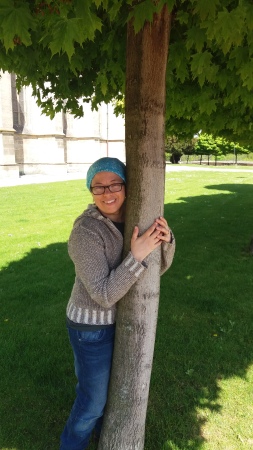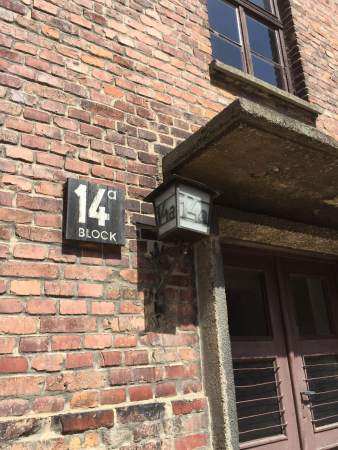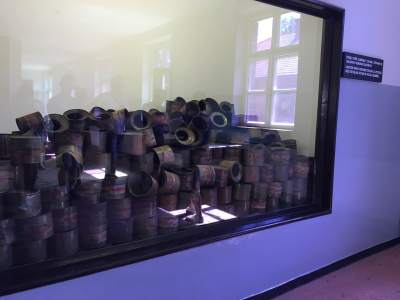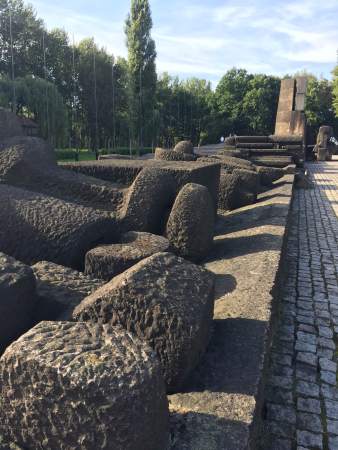 On August 4th, I visited Auschwitz. In the beginning, the reality of the experience did not match my surrealist expectations of it. I expected to walk onto the grounds and get hit over the head with the heaviness of what happened there, to feel a sense of deep connection to the land covered in the ashes of my people, to have the opportunity to mourn the loss of the members of my family I never met and to be utterly speechless as to the twisted systematization and industrialization of murder that took place there. That blow never came. Why?
On August 4th, I visited Auschwitz. In the beginning, the reality of the experience did not match my surrealist expectations of it. I expected to walk onto the grounds and get hit over the head with the heaviness of what happened there, to feel a sense of deep connection to the land covered in the ashes of my people, to have the opportunity to mourn the loss of the members of my family I never met and to be utterly speechless as to the twisted systematization and industrialization of murder that took place there. That blow never came. Why?
The day of my visit was out-of-this-world hot. My guided tour, in Czech, started at 2pm. I was early so I wandered among the crowd outside of the site. There were families lounging on the lawns eating ice creams and drinking cokes. There were tourists taking selfies. There were lots of conversations and lots of laughter. I was pretty convinced that I was the only Jew around.
Upon entering the grounds, I was stunned by how green and lush it was. There were many old brick buildings, seemingly orderly, with lanterns and building signs hanging outside the entrances. Among it all, upwards of 500 people clustered in groups walked from place to place.
The tour began with a basic history of the events of the Holocaust with “exhibits” contained within 3 or 4 different buildings. The guide seemed to me to have memorized a script in which we went from one building to another looking at the “exhibits,” most of which consisted of nothing more than one or two oversized pictures and maps. Outwardly, I sensed no sentiment in the guide and no spirit in the exhibitions either. Her voice was monotone, pronouncing the Czech in such a syllable-by-syllable fashion that it was nearly incomprehensible. Most exhibition rooms were sparse, if they had any objects at all other than the black and white pictures and maps. The tour and exhibitions portrayed such a distance from the events it was almost as if they didn’t happen there, in that place.

There were a few buildings with objects all hermetically sealed behind glass once again keeping us at a distance. One room housed a display of used Zyklon B canisters and had an artist’s small scale all-white model of the “process of extermination,” meaning the “changing rooms,” “showers” and crematoriums – with tiny people crammed into the areas and bodies piled on the floors next to the ovens. Two other buildings contained large displays, again behind glass and removed from their context, of what the exhibition called “evidence of the destruction:” piles of hair loosened from the burlaps sacks they had been founded in when the camp was liberated; shoes of the victims and a large (two-story) container filled with the pots and pans the victims had packed and brought with them but never used.
After we finished our tour of Auschwitz 1, we were given a 15 minute break and were instructed to reassemble by the bus that would take us to Auschwitz-Birkenau. Once there, we rushed through the camp at such a pace that we were done in about 45 minutes. In spite of the rush, I did manage to leave two stones on the pillars, which marked where the ashes of the victims were scattered (buried?). We glanced at the memorial at the back of the camp as well as what was left of the bombed-out crematoriums. Returning to the front of the camp, we ducked into a reconstructed dormitory and a reconstructed bathroom building. The guide asked if we had any questions. Silence. The tour was done.
reassemble by the bus that would take us to Auschwitz-Birkenau. Once there, we rushed through the camp at such a pace that we were done in about 45 minutes. In spite of the rush, I did manage to leave two stones on the pillars, which marked where the ashes of the victims were scattered (buried?). We glanced at the memorial at the back of the camp as well as what was left of the bombed-out crematoriums. Returning to the front of the camp, we ducked into a reconstructed dormitory and a reconstructed bathroom building. The guide asked if we had any questions. Silence. The tour was done.
I stood there debating what to do. Do I leave? Do I stay? I was pretty confident that it didn’t feel right to just go. So, I headed back to the memorial. The tour guide had said that each of the smaller stones creating the steps and floor commemorated one of the 1.1 million Jews killed in Auschwitz. Yet, it was unclear as to the meaning of the large stones. After circling the large stones and a futile attempt to make some meaning out of them, I went and sat on the stairs of the memorial and just looked out over the place and the people there.
 Still puzzled but needing to catch the train, I made my way to the entrance. In front of me was a group of Israeli Jews wrapped in Israeli flags, looking the Superhero part. Something changed. Maybe I didn’t need the sad, mournful, pit-of-the-stomach experience. Maybe I’ve had it enough, learned about it enough, taught it enough and lived with it enough. Maybe my pilgrimage there as a witness to the horrors was enough.
Still puzzled but needing to catch the train, I made my way to the entrance. In front of me was a group of Israeli Jews wrapped in Israeli flags, looking the Superhero part. Something changed. Maybe I didn’t need the sad, mournful, pit-of-the-stomach experience. Maybe I’ve had it enough, learned about it enough, taught it enough and lived with it enough. Maybe my pilgrimage there as a witness to the horrors was enough.
It was those Israeli Jews that I needed. Walking into Auschwitz was one thing, but they were proud Jews walking out. I followed them. We, Jews, were the lucky ones who got to leave. Isn’t that something!
Ivy Helman, Ph.D. is feminist scholar and faculty member at Charles University and Anglo-American University in Prague, Czech Republic where she teaches a variety of Jewish Studies and Ecofeminist courses. She is an Associate of Merrimack College‘s Center for the Study of Jewish-Christian-Muslim Relations and spent many years there as an Adjunct Lecturer in the Religious and Theological Studies Department.


Sounds like there is a need for a place to light a candle, lay a stone, meditate, or sit quietly. This is not an ordinary tourist site.
LikeLike
Felt like I was there with you. Thanks for such precise description ow what you saw, thought and felt.
LikeLike
I feel my generation ( I’m 71) has done a great disservice to the memory of those murdered in the concentration camps. As a child I heard a lot about the horrors of that time. I read Anne Frank many times. I pictured stars on sleeves, the round ups of Jews, the packed trains and what life and death must have been in the camps. It was all recent history. We were told in detail what happened and promised never again. As my children were born in the 1960’s & 1970s Vietnam was in the forefront. Yes, the schools included the Nazi crimes, but we, at home, didn’t speak much about it. Shame on us. We know of the Nazi mentality. We said “never again”. We feel the present danger in our midst now and fear the possibilities because we were taught in school and at home of Nazi horror. Our children are not seeing a repeat of history. They fear ISIS. A real and present danger exists here, now, in our own country. People at rallies cheering at a candidate’s bazaar and frightening comments. I see people of all ages following blindly. We failed our children by protecting them from horror brought on by a con artist.
LikeLike
I have met survivors of the camps, but they never spoke about their experiences. The Germans were hypnotized (captured>) by a spell-binding orator who was insane. Yes, it seems to be happening again. Yes, “never again.” Also, will we never learn?
LikeLike
I think I’m crying for the degradation of remembering as well as the historical event.
LikeLike
Barbara’s comment here, so much what I feel also.
LikeLike
Wonderful that you are hugging a tree, Ivy!
Did anyone hug trees back in the 1930’s and ’40’s when all those miseries and bombings and concentration camps were going on? Maybe there is hope for us now after all.
LikeLike
Sarah, I recommend the diaries and letters of Etty Hillesum: “An Interrupted Life” and “Letters from Westerbork.” Etty was what I imagine Anne Frank might have been like in her twenties, had she lived. Etty died at Auschwitz after she volunteered to accompany a transport from the Westerbork camp in the Netherlands where she worked during the war. At Westerbork, which I visited with my sister more than twenty five years ago, we found the purple wild lupines blooming on the edge of camp, the same ones she mentions in her letters from that place. She always saw the beauty of nature even in the midst of awful suffering and practiced forgiveness (including of the Nazi soldiers–she pitied them) which may be one of the reasons her story has not been embraced by Jews (she was Jewish) nor Christians (she admired the teachings of Jesus but did not convert).
LikeLike
How horrible that the tour guide led the tour in a monotone and everything seemed so removed from the terrible reality of what happened. Some years ago when I worked at the local high school a woman who was a survivor of the Holocaust came and spoke about her experience. She spoke in a monotone, too, but her words were powerful and gut-wrenching!
LikeLike
Molo,
An inspiring piece Ivy.
I am struck by the impersonal nature of the tour which likely contributed to your sense of unreality and disillusionment at the process.
In the end you found yourself in the collective identity of proudness (different to pride/arrogance)- a humble acknowledgement of your place now after this historical event.
Enkosi,
LikeLike
I was humbled to visit. And shamed for what happened.
LikeLike
And since it sent early, would you mind if I reblogged your post? This is what my interest and degree is in. I hope to learn and prevent anything as crazy as this from happening ever again. It’s amazing one man had that much control.
LikeLike
You can reblog any FAR post!
LikeLiked by 1 person
Thank you so very much. I’ve enjoyed so many!
LikeLike
Thank you all for your comments. I haven’t visited this blog specifically for a while just because I am still quite unsure how I feel about what I experienced. I think Carol is right – there needs to be some time to just “be” there and perhaps an opportunity for ritual (placing stones, lighting candles, davening, etc.). I also agree with bertrandleopengpsychology4all – that being proud is considerably different from pride/arrogance, especially considering what took place in the camps and that despite that one can feel good about their Jewishness.
My partner often distinguishes between two types of memorials related to the Shoah which I think are very helpful: those created by Jews for Jews and those created by Jews or non-Jews specifically targeting non-Jews. I think Auschwitz is a good example of the second variety while a place like Pinkas synagogue (in Prague) is a good example of the first type (The walls are lined with the names of the victims as well as their birth and death dates. It is simple and solemn. In the background, an audio recording plays alternating between El Maleh Rachamim and a recitation of the names. There is space to just be!)
LikeLike